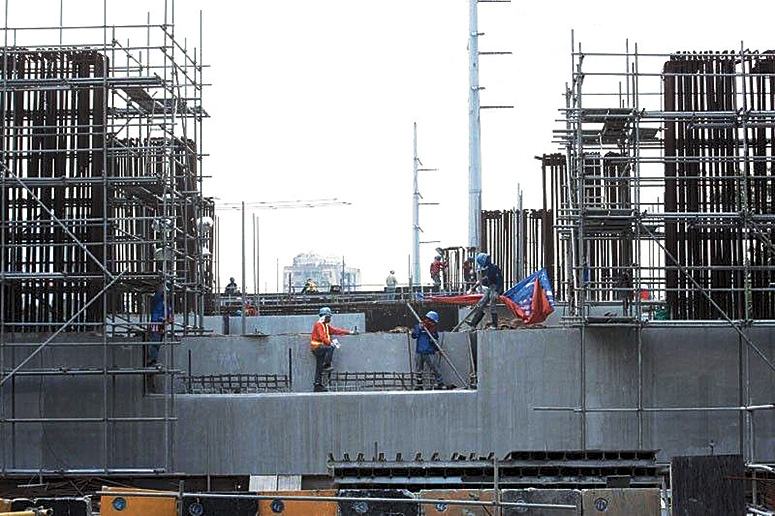When the Duterte administration vowed a massive infrastructure buildup, it put its money where its mouth is, literally.
Last year, the government returned to its usual infrastructure buildup by spending roughly P900 billion on public works and taking advantage of the lifting of quarantine restrictions nationwide.
In a report, the Department of Budget and Management (DBM) said that infrastructure spending jumped by 31 per cent to P895.1 billion in 2021 from P681.5 billion in 2020.
Primarily, the DBM said that the infrastructure bill went up by that much given the low base that was recorded in 2020 at the height of the pandemic. The government had to cancel or postpone the implementation of some projects in an effort to pour its resources on social interventions.
On the other hand, the DBM said that the Department of Public Works and Highways (DPWH) pushed through with the delivery of several road network, flood control and building construction projects in 2021.
It added that the government resumed the completion of foreign-funded undertakings on aviation and railways.
“The capital outlays of other departments, such as the Revised Armed Forces of the Philippines Modernization Program of the Department of National Defense and the Health Facilities Enhancement Program of the Department of Health also contributed to the higher infrastructure spending,” the DBM said.
Infra spending hits P1.1-T in 2021
When all infrastructure items are included such as subsidies for state-run firms and issuances to local governments, infrastructure spending grew to P1.12 trillion and contributed 5.8 percent of the gross domestic product (GDP) in 2021.

The Philippines exited recession with a GDP growth of 5.7 percent on the back of economic reopening, after declining by a post-war worst 9.6 percent in 2020 due to the COVID-19 lockdowns.
President Duterte may be scheduled to step down by June to give way to his successor, but his administration made sure that infrastructure spending would go on even in spite of the election ban. The government filed for the exemption of 18 projects from the spending prohibition.
The DBM computes that about P500 billion worth of projects were covered in the exemption like the Cebu-Mactan Bridge and Coastal Road construction, Ambal-Simuay River and Rio Grande de Mindanao river flood control as well as the Pasig-Marikina River and Manggahan floodway and bridges construction.
According to the DBM, the government also demanded an exemption from the election ban in completing its relief and rehabilitation efforts in areas hit by Typhoon Odette in December 2021.
Prior to the pandemic, the government posted a three per cent increase in infrastructure spending to P881.7 billion in 2019 from P859.4 billion in 2018, as state agencies carried the momentum of the government’s focus on public works through the massive infrastructure buildup.
When combined with equity for government-owned and controlled corporations and budgetary support for local governments, capital outlays spiraled by close to one percent to P1.04 trillion in 2019 from P1.03 trillion in 2018.
Gov’t wants to trim budget deficit despite infra push
The government wants to cut the budget deficit over the medium term to 7.7 per cent of the GDP in 2022 from 8.6 per cent last year, as part of a plan to bring it down to pre-pandemic levels, to 6.1 per cent in 2023 and 5.1 per cent in 2024.
It expects revenue collection to increase by an average of 10.2 per cent every year to hit a record P4.05 trillion by 2024. On the other hand, state spending is projected to grow but yet at a slower pace of 4.9 per cent, to P5.35 trillion by 2024.
In turn, the government will sustain its financing blitz for public works, but it may see its share to GDP reduced over time. Under the plan, infrastructure spending as a share of GDP will decline to 5.5 percent in 2023 and then 5.4 percent in 2024.
As expected after a crisis, the government is forced to consolidate its finances, where revenues should be raised and expenditures should be minimized, to slow the growth of public debt.
Department of Finance chief economist Gil Beltran said the government may need to explore public-private partnerships (PPPs) yet again to fund its big-ticket infrastructure projects due to a cash shortfall resulting from the Mandanas ruling.
“We now have to look at PPPs more intensively to find out where we can use the private sector resources to continue the Build Build Build program, which has been ongoing since the start of the Duterte administration,” Beltran said.
As mandated by the Supreme Court under the Mandanas ruling, the national government must raise the internal revenue share of local government units (LGUs) this year.
According to the budget department, local governments will receive a total of P959.04 billion this.
The Build, Build, Build program, President Duterte’s centerpiece program, favors the acquisition of external grants and loans, also known as official development assistance (ODA), to bankroll multiple projects listed under it.
The Duterte administration obtained $7.94 billion in ODAs just between July 2016 and December 2020, exceeding the ODAs secured by former presidents Gloria Macapagal Arroyo’s $6.06 billion and the late Benigno Aquino’s $5.64 billion.
However, the next administration may be compelled to revert to PPPs and set aside foreign funding for infrastructure projects.
